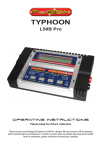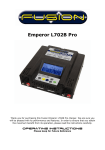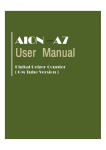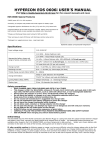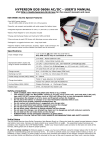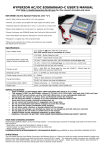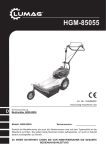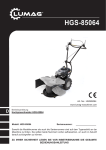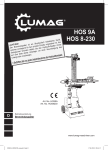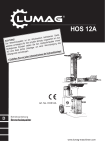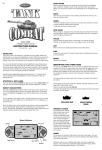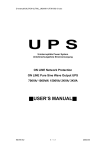Download opErAting instructions - Scorpio
Transcript
ETHOS LX41B Pro opErAting instructions Please keep for future reference Thank you for purchasing this Ethos LX41B Pro charger. We are sure you will be pleased with its performance and features. In order to ensure that you obtain the maximum benefit from its operation, please read these instructions carefully. SpEciFicAtions Input Voltage 11~15V DC 100~240V AC 50~60Hz Battery Type & Cells 1~4 Lithium-Ion cells (3.6V/cell) 1~4 Lithium-Polymer cells (3.7V/cell) 1~4 LiFePO4 cells (3.3V/cell) 1~12 Nickel-Cadmium cells (Ni-Cd) 1~12 Nickel-Metal Hydride cells (Ni-MH) Charge Rate 0.1A ~ 4A Adjustable in 100mA steps (Max 40W) Trickle Charge Rate 0 ~ 100mA (Ni-Cd & Ni-MH Only) Balancing Max. Current 120mA Balancing connector JST-EH type (4 cell) Charge Termination Li-Ion, Li-Po & Li-Fe Constant current/constant voltage NiCd/NiMH Delta Peak Delta Peak Sensitivity Ni-Cd Ni-MH 8mV/cell 5mV/cell SpECIAL FEATUrES • Built-in intelligent balancing circuit is designed to individually balance each cell on a lithium battery pack within the tolerance of 5mV during charge. • Balancing plug adaptor boards are supplied to suit FlightPower, Thunder Power and JST-XH batteries. Optional adaptors for Polyquest & 4/2mm plug car packs are available. • 2 line, 8 character, LCD makes the screen clear and legible. • Monitoring features allow the monitoring of capacity, peak voltage and individual cell voltages (Lithium only) on the screen during and after charging. • Various warning messages for incorrect input voltage, wrong connections, unsuitable battery condition and reverse polarity on output. 1 SAFEty prEcAutions •DO NOT attempt to charge incompatible types of rechargeable batteries. This charger is designed to only charge Nickel-Cadmium, Nickel-Metal Hydride, Lithium-Ion, Lithium-Polymer & LiFePO4 batteries. •Make sure you place the charger on a firm level surface for charging. •DO NOT attempt to charge batteries at excessive fast charge currents. Check with your battery manufacturer for the maximum charge rate applicable to your battery. •DO NOT use automotive type battery chargers to power the charger. •DO NOT leave the charger unattended while charging. Disconnect the battery and remove input power from charger immediately if the charger becomes hot. Allow the charger or battery to cool down before reconnecting. •DO NOT allow water, moisture or foreign objects into the charger. •DO NOT place the battery or charger on or near a flammable object while in use. Keep away from carpets, cluttered workbenches, etc. •DO NOT cover the air intake holes on the charger as this could cause the charger to overheat. •Connect the input leads to the mains or 12V power source first, then connect the battery. •DO NOT disassemble the charger. •This unit is not intended for use by young children or infirm persons unless they have been adequately supervised by a responsible person to ensure that they can use it safely. •Young children should be supervised to ensure that they do not play with the charger. •DO NOT attempt to charge whilst the input 12 volt battery is being charged, as the voltage supplied to the charger may be too high. •DO NOT attempt to charge non-rechargeable batteries. 2 Lithium Ion/polymEr BAttEry SAFEty WArnings Ensure that the charger and battery are placed on a non-flammable surface whilst charging and ideally charge outdoors wherever possible. NEVER charge a Lithium ION/Polymer/Fe battery inside a vehicle whatever the circumstances. ALWAYS ensure that the charger is correctly set for the battery being charged, checking both charge rate and cell count (Lithium Only). Be particularly careful if using a series/parallel battery pack, or if using packs of different specifications with the same charger. NEVER charge at a rate higher than that recommended by the cell manufacturer, this can be very dangerous. DO NOT leave Lithium ION/Polymer/Fe batteries unattended whilst they are charging. Monitoring the batteries during charging is very important. ALWAYS monitor the temperature of the battery being charged every few minutes. If the battery becomes hot to the touch, disconnect it from the charger immediately and allow to cool. DO NOT recommence charging until the battery and charger have been checked for compatibility and the charger settings have been confirmed as being correct. In the unlikely event of the Lithium ION/Polymer/Fe battery catching fire DO NOT use water to attempt to put the fire out, instead use sand or a fire extinguisher designed for electrical fires. When used correctly, Lithium ION/Polymer/Fe battery packs are as safe as any other type of rechargeable battery pack. However they do require different charge regimes to the longer established Nickel Cadmium and Nickel Metal Hydride technologies and have the potential of catching fire if severely mistreated. If Lithium Polymer battery packs are short-circuited or severely over-charged elemental Lithium may be deposited internally, and if the battery pouch is damaged this can escape from inside the battery. If this occurs a fire may be caused, as elemental Lithium is highly reactive when exposed to water or moisture, producing flammable hydrogen gas and corrosive fumes. Elemental Lithium is not produced unless the battery pack is severely mistreated, so in normal usage there is no likelihood of explosion or fire. 3 Lithium Ion/polymEr/FE BAttEriEs Lithium Ion/Polymer battery packs must NEVER be discharged below 3 volts per cell (Li-Fe 2.0V) as this will result in damage to the cells. If the voltage is allowed to drop below 3 volts per cell the battery voltage may seem to recover following a charge, but the battery may not then give its full nominal capacity and a reduction in performance is likely – allowing the voltage to drop below 3 volts per cell will invalidate all warranty claims. NEVER charge Lithium Polymer battery packs at greater than 4.2V per cell, Lithium Ion at 4.1V volts per cell or LiFe at greater than 3.7V per cell as this will cause irreversible damage to the cells and will invalidate all warranty claims. NEVER charge Lithium battery packs above their maximum charge rate. This can damage the pack and can be dangerous. Generally, Lithium Polymer packs should not be charged above 1C (1 x Capacity), although some newer packs do allow charging at 2C. e.g Li-Po pack of 2500mAh capacity : 1C = 2500mAh = 2.5A max charge current. DO NOT use discharge rates in excess of those specified with the battery pack as this will result in a significant drop in voltage under load and will dramatically reduce the number of charge/discharge cycles the battery pack will give. If disposing of Lithium battery packs ensure that the pack is fully discharged by using a light bulb, electric motor or similar to completely discharge the pack. DO NOT allow any Lithium battery pack to short-circuit as this is likely to result in a minor explosion and consequent fire. BEFORE charging any Lithium battery packs they should be closely inspected for any damage, such as punctures in the sleeving or if the battery has swollen or expanded in size. If any such damage is detected DO NOT charge, even if the battery otherwise appears to be brand new. Before commencing charging ALWAYS double check the settings on the charger to ensure it is set correctly for the battery pack to be charged. Using the wrong settings is likely to result in damage to the battery pack being charged and could result in the battery catching fire. 4 Input powEr 12V DC Connect the 12V input lead to the charger, then red alligator clip to the positive (+) terminal on the power source and the black alligator clip to the negative (-) terminal. The charger will display “Input voltage” error message if the input is below 11V or above 15V. If this happens, please recheck the input power supply to make sure correct power is present. OR 100~240V AC Connect the mains lead to the charger, then connect the AC plug to a regular AC100~240V wall socket. NOTE: If AC power is being used for input power, do NOT try to connect the 12V DC power as well! Output BAttEry ConnEctions Two 4mm banana sockets are located on the right side of the charger. Connect the battery main power leads to these sockets with the positive (+) lead connected to the red socket and the negative (-) lead to the black socket. You may need to purchase an adaptor lead to suit the specific connector on you battery and make this more convenient. The “No battery” error message will be displayed if trying to start charging without connecting a battery to these sockets. The “Open Circuit” error message will be displayed if a battery becomes disconnected from the charger while a function is in progress. A “Reverse Polarity” error message will be displayed if a battery is connected to the charger in reverse. Note: In order to balance Lithium batteries during charge, please ensure that both the battery main power leads and the balancing connector from the battery pack are connected to both 4mm output banana sockets and balancing port respectively. The balancing port (JST EH type) requires a short lead (supplied) and an adaptor board to suit other battery balance connectors. Adaptor boards for Flight Power/Thunder Power and JST-XH batteries are included. Optional adaptors for Polyquest & 4/2mm plug car packs are available. If the main battery power leads ONLY are connected to the output banana sockets, without connecting the balancing connector to the balancing port on the charger, the charger will charge or discharge the connected Lithium pack without balancing it. 5 gEnErAl OpErAtion • When the charger is first connected to the power source the charger will show the battery type that was last used. • If the BATT TYPE button is briefly pressed, the current battery type (NiCd, NiMH, Li-Ion, Li-Po, Li-Fe ) will flash. By pressing the BATT TYPE button again, the next battery type will be selected, as shown in the flow-chart below. NiCd 1.0A BATT TYPE NiMH 1.0A BATT TYPE LiIo BATT TYPE LiPo BATT TYPE 1.0A 3CL 1.0A 3CL LiFe 1.0A BATT TYPE 3CL progrAmming NiCd & NiMH Modes Li-Ion, Li-Po & Li-Fe Modes BATT TYPE LiPO 2.0A ENTER BATT TYPE NiCd 1.0A ENTER INC NiCd 3.0A START INC LiPO 2.5A DEC DEC 3CL INC LiPO 2.5A BATTERY CHECK.... 3CL DEC 2CL START 2.98A 8.421V 2 secs BALANCER NOT CON. NiCd CHG 0:04 BALANCER CON. BATTERY CHECK.... 2.49A 7.895V NiMH 3.0A LiPo 3.0A 2CL 2 secs LiPo BLC 0:04 Setting Charge Current Adjust the desired charge current, which ranges from 0.1A to 4.0A with the INC & DEC buttons. Press the ENTER button to confirm the setting. Setting the Number of Lithium Cells Using the INC and DEC buttons adjust the number of cells to match the battery being charged and press the ENTER button to confirm the setting. (Only required for Lithium batteries) 6 • If another button is pressed, or nothing is pressed, the current battery type stops flashing and is selected. • If the BATT TYPE button is pressed and briefly held, the input and output voltages are shown, until the BATT TYPE button is pressed again. • If the ENTER button is briefly pressed, the first adjustable parameter starts to flash, then if the ENTER button is pressed again, the next parameter starts to flash. If nothing is pressed for 5 seconds, the parameter stops flashing. INC DEC • When flashing, the parameters can be adjusted using the and buttons. START the charge the ENTER button is pressed and briefly held. • To ‘ ’ ScrEEn DisplAys Displays During Charge CHG: Charge “BLC” will be shown if the balancer cable of the battery is connected to the balancing port of the charger. LiPo CHG 0:04 2.49A 7.895V 2 secs If the Enter button is pressed at any stage, the charge can be terminated. Completion Display (with Audible Warning) LiPo END 42:52 2 secs 0.00A 12.522V In order to move to the main display, press the Enter button. Data Display In order to move to the main display, press the Enter button. I = 12.05V DEC O=12.52V INC ChgCAPA DEC 01205mAh INC ChgPEAK DEC O=12.61V INC LCB-[01] DEC 4.174V INC MAX4.18V DEC MIN4.16V INC ENTER ENTER “LCB” - Lithium Cell Balancer. Using the ‘INC’ and ‘DEC’ buttons you can view the voltage of individual cells. DEC LCB-[02] 4.168V IMPORTANT NOTE INC The maximum voltage for Li-Ion is 4.1V per cell, 4.2V per cell for Li-Po batteries and 3.7V per cell for Li-Fe batteries. Therefore, it is extremely important to choose the correct Lithium battery type and number of cells to be charged, as each Lithium battery has a different voltage level. If not, it may cause very serious damage to the batteries and increase the risk of a fire! 7 Error mEssAgEs INPUT VOLTAGE Input voltage is below 11.0V or exceeds 15V. NO BATTERY Battery is not connected to the charger’s output banana sockets. REVERSE POLARITY Battery is connected to the output banana sockets in reverse. CIRCUIT PROBLEM BAT.OPEN CIRCUIT A circuit error has been detected during battery checking. Battery has become disconnected during an operation. OVER BAT VOLTAGE The wrong number of cells has been set while charging Lithium batteries. LOW BAT VOLTAGE Wrong number of cells has been set, or batteries are over discharged, while charging Lithium batteries. HIGH BLC VOLTAGE A high voltage cell has been detected during balancing. The pack may be faulty. LOW BLC VOLTAGE A low voltage cell or short circuit has been detected during balancing. The pack may be faulty. DONT CHG LiXX There is a lithium battery balancing lead connected to the charger, but the charger is set to either NiCd or NiMH charge mode. This helps prevent charging Lithium batteries in the wrong charge mode. 8 9 www.LogicrC.com Logic RC Limited 14 Hartham Lane Hertford SG14 1QN United Kingdom rev. 04/2009












